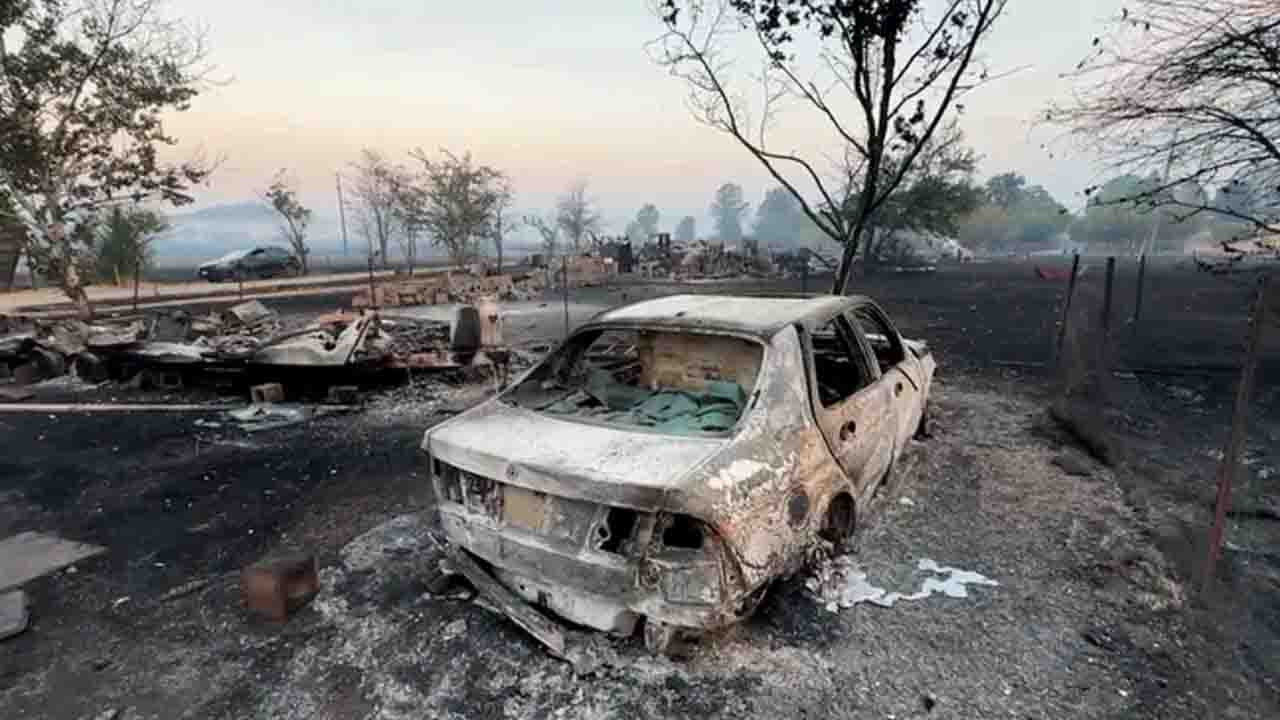A fast-moving wildfire, ignited by a rare lightning storm, tore through the historic Gold Rush town of Chinese Camp in Tuolumne County, California, on September 2, 2025, leaving behind a trail of destruction. The blaze, known as the 6-5 Fire and part of the TCU September Lightning kompleks, has scorched thousands of acres, destroyed homes, and threatened the town’s remaining historic structures, forcing the evacuation of its roughly 100 residents. As firefighters battle the uncontrolled inferno amidst challenging terrain and dry conditions, the community grapples with the loss of its cherished heritage and the uncertainty of rebuilding.
A Historic Town Under Siege
Chinese Camp, located approximately 57 miles east of Stockton and 40 miles from Yosemite National Park, is a registered California landmark with deep historical significance. Settled in the 1850s by Chinese miners who faced persecution and were driven out of nearby camps, the town once thrived as a bustling hub during the Gold Rush, home to over 5,000 residents, predominantly from Guangdong, China. It served as a stagecoach stop and supply center, linking small Chinatowns and multicultural mining communities across the Sierra Nevada foothills. Today, with a population of about 61, Chinese Camp is a quiet pass-through for tourists, its Main Street lined with historic structures like a post office built in 1854, a shuttered Catholic church from 1855, and the Chinese Camp Store and Tavern, a community gathering spot since 1934.
The 6-5 Fire, sparked by one of over 16,000 lightning strikes that hit California on September 2, 2025, rapidly grew to 6,965 acres by September 4, with zero containment reported by Cal Fire. Fueled by critically dry grass, brush, and timber, the blaze swept through Chinese Camp, reducing homes, businesses, and vehicles to smoldering rubble and charred brick walls. Visual reports from local media, including KCRA and the San Francisco Chronicle, captured the devastation: blackened pavement, collapsed buildings, and scorched trees, with thick smoke lingering over the town. Residents, like Randall Hoffman, worked frantically alongside firefighters, shoveling sand and clearing vegetation to prevent flames from spreading, though many structures could not be saved.
Evacuations and Firefighting Efforts
The rapid spread of the 6-5 Fire prompted mandatory evacuation orders for Chinese Camp and surrounding areas, including Six Bit Ranch Road, Red Hill Road, and Old Don Pedro Road. The Tuolumne County Sheriff’s Office deployed over 40 personnel to assist with evacuations and secure the area, while Cal Fire mobilized 1,254 firefighters, supported by engines, bulldozers, and aircraft dropping fire retardant. The closure of Highway 120, a key route to Yosemite, disrupted travel, with additional roadblocks on surrounding routes like Jacksonville Road. Evacuation shelters were established at Bret Harte High School in Altaville and the Sonora Senior Center, accommodating residents and their pets, with livestock evacuation centers opened at the Calaveras County Fairgrounds.
Cal Fire reported that the TCU September Lightning kompleks, comprising at least 16 fires across Tuolumne, Calaveras, and Stanislaus counties, had burned 13,790 acres by September 4, with containment reaching 15% for the kompleks but remaining at 0% for the 6-5 Fire. The rugged terrain, combined with low humidity and gusty winds, has made firefighting efforts challenging, with crews hiking to remote locations to establish containment lines. Governor Gavin Newsom secured a Fire Management Assistance Grant from FEMA to bolster resources, emphasizing the state’s commitment to combating the crisis. “We are securing all available resources to fight this growing lightning kompleks fire,” Newsom stated, noting the storm’s unprecedented 9,000+ lightning strikes.
Impact on Chinese Camp’s Heritage
The fire’s impact on Chinese Camp’s historic structures remains under assessment, with Cal Fire’s damage inspection team working to catalog losses. Early reports indicate that the Chinese Camp School and the general store survived, as did the 1855 Catholic church, though many homes—both traditional and mobile—were reduced to ashes. The status of other Gold Rush-era landmarks, such as the 1854 post office and remnants of the town’s original Chinatown, including stone foundations and the historic jail, is unclear. The loss of any of these structures would be a significant blow to California’s cultural heritage, as Chinese Camp represents a vital chapter in the story of Chinese immigrants who faced discriminatory policies like the 1852 Foreign Miners Tax yet built a resilient community.
“This is a lot of history that was lost,” a Cal Fire firefighter remarked, echoing the sentiments of residents like Randall Hoffman, who narrowly saved his property but mourned the town’s devastation. Community leaders, who have long worked to preserve Chinese Camp’s legacy, now face the daunting task of rebuilding. “This town will rebuild,” Hoffman told the San Francisco Chronicle, standing amidst a charred field. “From the literal ashes, it will rise again.”
Broader Context and Ongoing Challenges
The 6-5 Fire is one of 22 blazes within the TCU September Lightning kompleks, which has collectively scorched over 13,700 acres across the region. The fires, fueled by a dry thunderstorm system that delivered over 10,000 lightning strikes with little rainfall, highlight the growing threat of wildfires in California, exacerbated by climate-driven heat and drought. Cal Fire reported over 6,500 wildfires in 2025 alone, burning nearly 500,000 acres, with lightning-caused fires proving particularly destructive. The agency warns of hidden fire risks, such as embers smoldering in tree roots, which could reignite if conditions worsen.
Air quality in Northern California has deteriorated, with unhealthy levels of particulate matter (PM2.5) prompting advisories for residents to stay indoors. The combination of high winds, steep terrain, and downed power lines continues to challenge firefighting efforts, with Cal Fire urging residents to maintain defensible spaces and prepare emergency kits. Evacuation orders in parts of Calaveras County were downgraded to warnings by September 4, but Tuolumne County remains under strict evacuation protocols, with officials emphasizing the need for vigilance.
Community Resilience and the Road Ahead
Despite the devastation, stories of resilience have emerged. Residents like Layne Smith were seen clearing vegetation to protect homes, while others, like brothers Joe and James Keefe, helped save a neighbor’s property. The survival of the Chinese Camp School, a symbol of the town’s enduring spirit, offers hope amidst the loss. As damage assessments continue, the community faces a long road to recovery, with the potential loss of historic structures adding emotional weight to the rebuilding process.
The TCU September Lightning kompleks serves as a stark reminder of California’s vulnerability to climate-driven wildfires. With no immediate containment in sight for the 6-5 Fire, Chinese Camp’s residents and officials are rallying to protect what remains and plan for the future. The town’s history of overcoming adversity—born from the perseverance of Chinese immigrants in the face of discrimination—may yet inspire its next chapter. For now, the focus remains on containment and recovery, as this small but storied community begins to heal from the flames.










